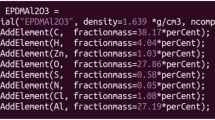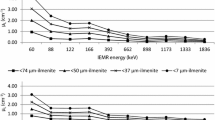Abstract
Neutron shielding generally is made of polymeric base content with a neutron absorption additive material. Optimization of additive neutron absorption material and minimizing of polymeric base thickness are surveyed and performed in this research. Response Surface Methodology (RSM) is used in this research study to investigate the simultaneous effect of the mentioned parameters on the radiation shielding efficiency of polymer composite. The RSM technique uses a second-order polynomial model for obtaining the optimum response of an outcome. With 2 independent variables including boron filler content and polymer thickness, 26 experiments are designed by Design Expert software. MCNP Monte Carlo simulation is performed for these 26 experiments according to the stand test data and designed shielding slabs and the outputs are imported to the Design Expert software which the result of that are response surfaces. Results of statistical analysis of variance (ANOVA) show that the p-value for the model is less than 0.05 and the value of R2 is also equal to 0.9970, which demonstrate good agreement between simulation data and proposed model using RSM. For shielding efficiency of fast neutron source, in optimization condition, the boron percentage content is 8.5% and the shield thickness is 100 mm and in minimizing condition, the boron percentage content is 20% and the minimized shield thickness is 71 mm. For thermal neutron source, the boron percentage content is 19.5% and the shield thickness is 594 microns in optimization condition and in minimizing condition, the boron percentage content is 17.4% and the minimized shield thickness is 462 microns. The optimum and minimize conditions for fast and thermal neutron sources predicted by model were validated by MCNP simulation for all responses, which reported a variation of less than 5%, and shows that the presented model is suitable for the design and construction of radiation polymeric composite shields. By implementing this research results using RSM as an efficient optimization tool, additive material can be optimized, and also base shield thickness can be minimized as performed in this study for designing a desired shield with minimum thickness for multipurpose cases.



Similar content being viewed by others
Data availability
This manuscript has no associated data or the data will not be deposited. [Authors’ comment: There are no associated data available.]
References
Z. Soltani, A. Beigzadeh, F. Ziaie, E. Asadi, Effect of particle size and percentages of Boron carbide on the thermal neutron radiation shielding properties of HDPE/B4C composite: experimental and simulation studies. Radiat. Phys. Chem. 127, 182–187 (2016)
X. Li, J. Wu, C. Tang, Z. He, P. Yuan, Y. Sun, W.M. Lau, K. Zhang, J. Mei, Y. Huang, High temperature resistant polyimide/boron carbide composites for neutron radiation shielding. Compos. B Eng. 159, 355–361 (2019)
J. Park, S. Her, S. Cho, S.M. Woo, S. Bae, Synthesis and characterization of Polyethylene/B4C composite, and its neutron shielding performance in cementitious materials: experimental and simulation studies. Cement Concr. Compos. 129, 104458 (2022)
S. Kim, Y. Ahn, S.H. Song, D. Lee, Tungsten nanoparticle anchoring on boron nitride nanosheet-based polymer nanocomposites for complex radiation shielding. Compos. Sci. Technol. 221, 109353 (2022)
Y.-C. Liao, Xu. Dui-Gong, P.-C. Zhang, B4C/NRL flexible films for thermal neutron shielding. Nucl. Sci. Tech. 29(2), 1–9 (2018)
E. Mansouri, A. Mesbahi, R. Malekzadeh, A. Ghasemi Janghjoo, M.U.R.A.T. Okutan, A review on neutron shielding performance of nanocomposite materials. Int. J. Radiat. Res. 18(4), 611–622 (2020)
C.V. More, Z. Alsayed, M. Badawi, A. Thabet, P.P. Pawar, Polymeric composite materials for radiation shielding: a review. Environ. Chem. Lett. 19(3), 2057–2090 (2021)
Z. Chen, Z. Zhang, J. Xie, Q. Guo, Yu. Tao, P. Zhao, Z. Liu, C. Xie, Multi-objective optimization strategies for radiation shielding design with genetic algorithm. Comput. Phys. Commun. 260, 107267 (2021)
Y. Cai, Hu. Huasi, Z. Pan, Hu. Guang, T. Zhang, A method to optimize the shield compact and lightweight combining the structure with components together by genetic algorithm and MCNP code. Appl. Radiat. Isot. 139, 169–174 (2018)
G. Hu, H. Hu, Z. Pan, Y. Cai, D. Wang, M. Yan, W. Sun, A novel method for designing the radiation shield against mixed neutrons and γ-rays (revised). Inst. Methods Phys. Res. A. (2017)
J.M. Kebwaro, Y. Zhao, C. He, Design and optimization of HPLWR high pressure turbine gamma ray shield. Nucl. Eng. Des. 284, 293–299 (2015)
M.A. Tunes, C.R.E. De Oliveira, C.G. Schön, Multi-objective optimization of a compact pressurized water nuclear reactor computational model for biological shielding design using innovative materials. Nucl. Eng. Des. 313, 20–28 (2017)
D.C. Montgomery, Design and analysis of experiments (Wiley, 2017)
A.I. Khuri, S. Mukhopadhyay, Response surface methodology. Wiley Interdisciplin. Rev.: Comput. Stat. 2(2), 128–149 (2010)
M.H. Flaifel, An approach towards optimization appraisal of thermal conductivity of magnetic thermoplastic elastomeric nanocomposites using response surface methodology. Polymers 12(9), 2030 (2020)
M. Kumari, S.K. Gupta, Response surface methodological (RSM) approach for optimizing the removal of trihalomethanes (THMs) and its precursor’s by surfactant modified magnetic nanoadsorbents (sMNP)—an endeavor to diminish probable cancer risk. Sci. Rep. 9(1), 1–11 (2019)
Author information
Authors and Affiliations
Corresponding author
Rights and permissions
Springer Nature or its licensor (e.g. a society or other partner) holds exclusive rights to this article under a publishing agreement with the author(s) or other rightsholder(s); author self-archiving of the accepted manuscript version of this article is solely governed by the terms of such publishing agreement and applicable law.
About this article
Cite this article
Rahimi, G., Chirlesan, D. & Soltani, Z. Optimization of filler content and minimizing thickness of polymeric composite for shielding against neutron source by Response Surface Methodology (RSM) and Monte Carlo simulation. Eur. Phys. J. Spec. Top. 232, 1657–1663 (2023). https://doi.org/10.1140/epjs/s11734-023-00904-7
Received:
Accepted:
Published:
Issue Date:
DOI: https://doi.org/10.1140/epjs/s11734-023-00904-7




